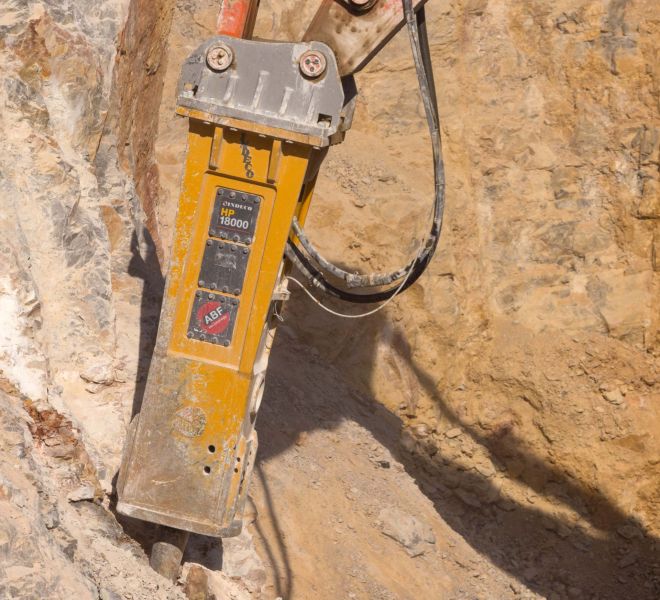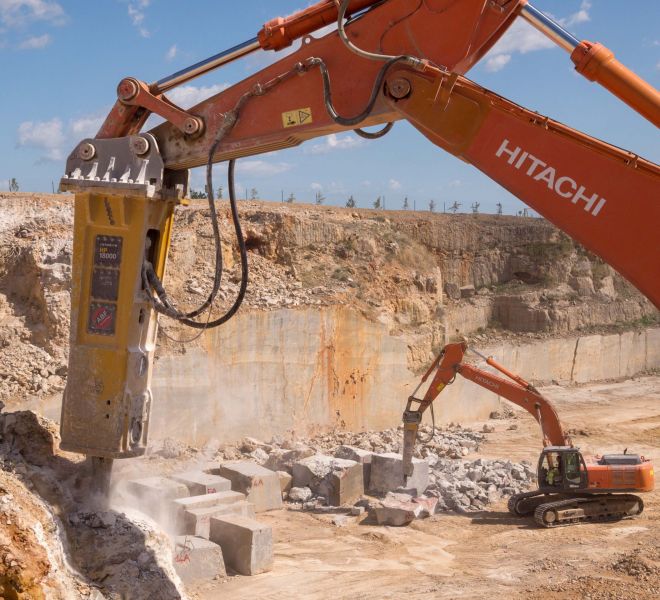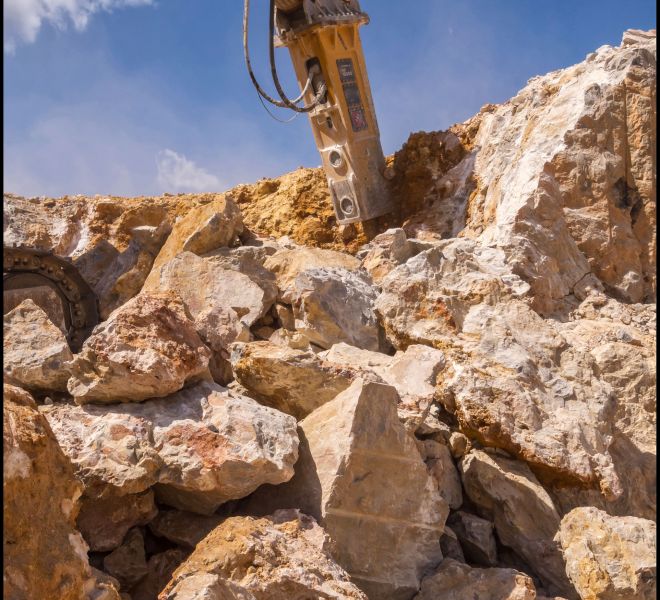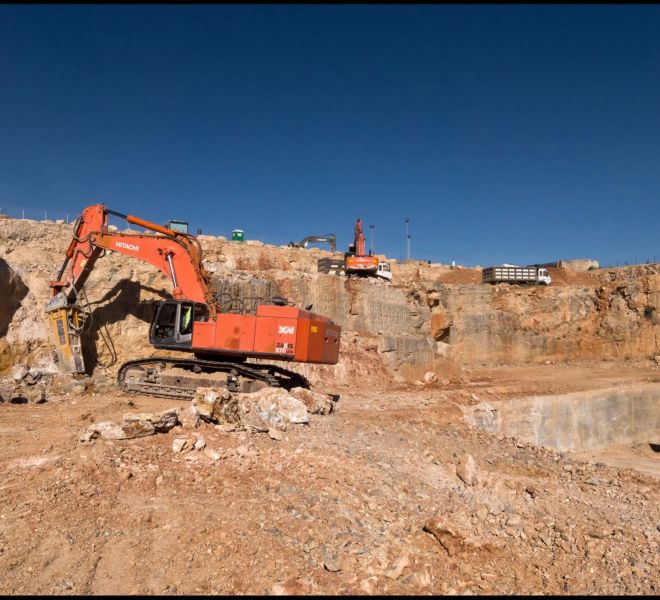An HP 18000 takes on the ballast challenge
In a quarry near Canosa di Puglia in the southern Italian region of Apulia that produces railway track ballast, an Indeco HP 18000 FS (Fuel Saving) hydraulic breaker again proves to be the best alternative to drilling and blasting when explosives are not an option.
The Pozzelle quarry is located a few kilometers from Canosa di Puglia (in the province of Barletta-Andria-Trani) along provincial road 181 and is characterized by the occurrence of Ambrato and Serpeggiante marble typical of the area. Active since the late 1980s and managed by the company CO.MA Srl, the quarry recently showed to have good potential for the production of crushed stone used for track ballast. A set of surveys and laboratory analyses indicated that the deposit also contained metamorphic carbonate rock with dolomitic characteristics dating back to the formation of the Apula platform during the Cretaceous period. The rock is considered ideal for the production of ballast because it meets the standards contained in UNI EN 13450 of the general contract specifications for civil engineering works (part ii – section 17) of RFI (Italian Railways). These specifications provide that the track ballast be produced with material found only in nature, that it be possessed of good compression strength, resistance to abrasion (Los Angeles coefficient) and to frost and be free of harmful fibers such as asbestos. Laboratory tests demonstrated that rock samples from the Pozzelle quarry had a strength of 139-144 MPa and a resistance to abrasion according to RFI LArb values of under 20, thus being classified as ballast of the first (LArb ˂16) or second (LArb ˂20) category depending on the case.
Quarrying without explosives
The proximity to provincial road 181 and the need to reduce the quantity of dust produced due to the intense agricultural activity taking place around the quarry precluded drilling and blasting, a method never used anyway since the site had been destined from the beginning for quarrying blocks for ornamental stone, a process performed instead by mechanical cutting. The unfeasibility of using explosives, a better technique for producing large quantities such as track ballast, prompted CO.MA Srl to consult a company with the experience and machinery to perform the full quarrying cycle, the primary and secondary crushing, as well as its stockpiling. Production was contracted out to D’Oria Giuseppe e C. Srl from Andria, which has experience operating in the roadworks and concrete sector. As we were referred to by quarry manager, the particular strength of the rock and the processes required to produce a quality material called for a company with expertise in the aggregates sector: “This quarry is unique because depending on the quarry face, either ornamental stone or material for track ballast can be produced. For a certain period, these two activities will be conducted in parallel though not in equal percentage; in fact, it will be the ballast that will be commanding most of our efforts. That said, aggregate production differs greatly in the quarrying techniques and logistics employed compared to ornamental stone. These are the reasons why CO.MA Srl preferred to give the job to a specialist.” To best handle the difficult task of quarrying a material of such hardness and unconfined compressive strength, which never goes below the 100 MPa, and with very little fracturing, the contractor D’Oria decided to purchase an Indeco HP 18000 FS and a Hitachi 870 90-ton excavator which it paired up with another Hitachi Zaxis 350 33-ton excavator mounted with an HP 9000 the company already owned. The second breaker is used to reduce the blocks designated for ornamental stone, which whether due to imperfections or cracks must instead be utilized as a material for ballast production; however, this second breaker is put to work especially to reduce the volume of material designated for ballast produced by the HP 18000, at times in dimensions too large to enter the crusher for primary crushing.
The challenge of ballast
The production of track ballast is subject to rigid requirements by RFI on both quality and quantity. In practice, the supplier, in addition to guaranteeing the characteristics laid down in the specifications, must assure that the material is stored and stockpiled in a controlled manner, that the storage areas must be identified, and that these areas guarantee that the material withdrawn maintain certain standards. This, essentially, involves that all phases of production that come after the quarrying of the rock (i.e., handling, crushing, screening, storing and loading) must guarantee product quality. The capacity to perform production and logistics was also underlined by Giuseppe Massari, the CEO of D’Oria: “Although we have considerable experience and enjoy an excellent reputation in the concrete production sector, which at any rate involves the management of aggregates, ballast is something else. We had to equip ourselves very specifically for this activity — one I do not hesitate to define as challenging — first with a breaker such as the HP 18000 FS, the only one currently on the market with such size and power. The equipment assures the targeted rate of production, approximately 700-800 cu m of material quarried in an eight-hour shift, without failing to deliver excellent performance and reliability. This is not a secondary issue because by the end of the year we have to have 50,000 cu m of material ready for delivery, since RFI wants to have ballast available at a moment’s notice. And it is exactly for this reason why the other phases, i.e., the primary crushing performed in the quarry, followed by secondary crushing, screening and cleaning carried out here at our headquarters, must be monitored carefully. The choice of the HP 18000 was extremely important because it gave us the possibility to solve the first and most important problem, that is, the production of material, which is truly very hard and not fractured. In this quarry the power of the breaker and the experience of our operators are maximized to the fullest.”
HP 18000, the solution for large-scale production
Designed to respond to special quarrying requirements where large-scale production is demanded, the Indeco HP 18000 FS is having success in markets where drilling and blasting has seen a gradual decrease. Today Indeco is the only producer to offer a breaker with 25,000 joules, a machine that nevertheless maintains the versatility and rapidity of a smaller class of breakers. Despite the large size and high performance, the HP 18000 FS also has the advantage of being coupled with 90-ton excavators, a feature that translates into higher mobility in the quarry and especially lower fuel consumption, and that means higher profitability. With a striking rate that can get up to 460 blows/min and a 250 mm chisel, the HP 18000 FS can assure impressive productivity if we consider the quantity of rock that is broken up and demolished. The HP 18000 FS, like the rest of Indeco breakers, also boasts a ratio between input and output power highly favorable for achieving optimum efficiency. The breaker also comes with the ABF (anti-blank firing) system, a patented technology that only Indeco offers, which considerably improves efficiency and extends the life of the breakers.











